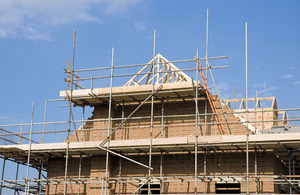Cutting needless red tape to help build more affordable homes
Communities Minister Don Foster announces proposals to simplify confusing housing standards.

Construction site
Dozens of unnecessary and confusing measures imposed on house builders by councils and government will be scrapped under proposals put forward today (20 August 2013) by Communities Minister Don Foster. This will help free up the industry, support growth and get high quality homes built.
Essential safety and accessibility rules will not be changed, but a mass of additional and often confusing housing standards that councils are free to apply locally – creating a patchwork of different standards – are proposed to be reduced from over 100 to fewer than 10. It’s also planned to reduce more than 1,500 pages of guidance to fewer than 80, saving councils and house builders time and money. No changes are being made to planning rules.
Taking off the bureaucratic handbrake
Don Foster said:
At a time when we are working closely with British business to create jobs and build a stronger economy it’s essential the government plays its part by taking off the bureaucratic handbrake that holds back house building and adds unnecessary cost. I’m proposing to cut needless red tape to let house builders get on with the real job of building the high quality new homes that people need, especially families and first time buyers.
The government last week published its latest figures on housebuilding starts, showing an increase of a third on the same period last year with ministers commenting that while there is more to do the figures reinforce the momentum towards getting Britain building again.
Over 100 housing standards are currently available to councils to apply locally, including the following which are facing abolition:
- requirements for rainwater harvesting in places that don’t suffer from water shortages
- demands for solar and wind energy sources that can’t physically fit onto the roofs of apartment buildings
- a stipulation for multiple phone lines in home offices, irrespective of need and in addition to broadband connection
- requirements to build accessible flats on floors that can’t be reached by disabled people
- rules on window sizes that include a ‘dirty window factor’ - imposing bigger windows to allow for dirt on them, rather than assuming people will have the common sense to clean them to let more light in
Don Foster added:
The current mish-mash of housing standards means that from Allerdale in Cumbria to Zoar in Cornwall no same set of rules always applies – it’s confusing, bureaucratic and cannot be allowed to continue.
The government is however inviting views on minimum space and access standards that would allow councils to seek bigger homes to meet local needs, including those of older and disabled people.
Read the full list of measures the government is consulting on reducing substantially.
No changes are being made to building regulations, which deal with safety and energy efficiency, although the consultation asks if some standards should eventually go into the regulations. Recent changes made to building regulations will further improve the quality and energy efficiency of new homes, saving occupiers £200 a year in fuel bills for a typical home and businesses in new large offices over £60,000 compared to building regulations before 2010.
Harry Rich, Chief Executive of the Royal Institute of British Architects said:
This rationalisation of local housing standards is important to ensure quality for its consumers across the country and certainty for the industry. We are pleased to see the government consulting on space standards, our public research has repeatedly revealed that space in new homes is a major concern.
David Orr, chief executive of National Housing Federation said:
We were involved in the housing standards review because we want to see greater consistency and clarity across standards for all new housing. For truly sustainable new homes that will provide enough space for families to grow, have low fuel bills and reflect local character and conditions we need strong guidelines that ensure good homes are built, but without imposing needless or inappropriate requirements. Moving from 100 standards to 10 is a good start in reducing red tape while safeguarding good quality home building but we look forward to seeing further details of the review.
Further information
Following this consultation, the government will set out clearly which housing standards will continue, and this will be accompanied by an associated planning statement.
A period of transition will be allowed to phase out certain standards, such as the code for sustainable homes, due to existing contractual or legal commitments. For the handful of housing standards that will be kept, councils will only be able to apply them after conducting a rigorous viability and need assessment.
This review was supported by the ‘red tape challenge’, launched by the Prime Minister in April 2011 to support departments in examining inherited regulations and scrapping or significantly reducing as many as possible. It gives business and the public the chance to have their say on regulations that affect their everyday lives. The housing and construction red tape challenge was open for comment from 12 January to 17 February 2012. More information can be found on the red tape challenge website
Royal Institute of British Architects surveys show that 60% of people who would not buy a new home said the small size of rooms was the most important reason, and 80% of people said they would be more likely to choose to rent or buy a home that meets a minimum space standard.